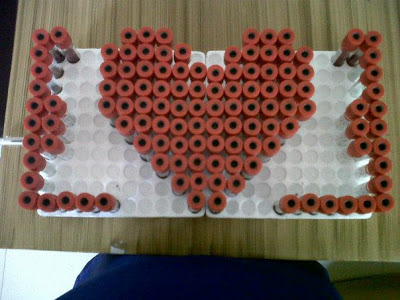1.
It is the law applied to
spectrophotometry:
a. Beer-Lambert’s Law c.
Kirchoff’s Law
b. Newton’s Law d. Absorptivity coeffecient
e.
NIL
2.
The following are basic
components of the spectrophotometer, except;
a. burner assembly c. cuvette
e. NIL
b. monochomator d. exit slit
3.The more light absorbed, the
higher the concentration of analyte in
this technique of measuring the amount of light absorbed by a solution:
a. atomic absorption d. fluorometry
b. nephelometry e.
NIL
c. spectrophotometry
4.
The basis of EFP is the measurement of:
a.
light given off by excited
atoms
b.
light absorbed at wavelength of
resonance line by dissociated atoms
c.
energy emitted by ultraviolet
treated atoms
d.
energy emitted by infrared
treated atoms
e.
NIL
5. 2- log T is
a definition of (T= transmission):
a. absorbance d. electron density e.
NIL
b. ionic strength e. electrophoretic density
6. In Osmometry, concentration of substance can be measured by:
a. colorimetry d. freezing point
depression
b. appropriate filters e. NIL
c. ionized atoms
7. Quenching is a problem in analysis of:
a. ultraviolet spectrophotometry d. flame photometry
b. fluorescence e. NIL
c. atomic absorption
8. For AAS measurements the light source is usually the:
a. hollow cathode
lamp d.
Tungsten light bulb
b. Deuterium lamp e.
NIL
c. halogen lamp
9. Electrophoresis is used to measure :
a.
ultraviolet substances e.
NIL
b.
infrared absorbing materials
c.
charged particles
d.
colored solutions
10. The reagent blank corrects for absorbance caused by:
a.
the color of reagents e. NIL
b.
sample turbidity
c.
bilirubin and hemolysis
d.
all of the above
11. The internal standards in EFP, are:
- Didymium and lithium
- Cesium and lithium
- Potassium and didymium
- Cesium and didymium
- NIL
12. The parts of the burner assembly are the following:
- Aspirator, atomizer, flame
- Aspirator, ionizer, flame
- Atomizer, emitter, flame
- Atomizer, ionizer, flame
- NIL
13. The most accurate vessel in volumetric measurements is the:
a.
Erlenmeyer flask
b.
Graduated cylinder
c.
Serological pipette
d.
Volumetric flask
e.
NIL
14. Volumetric measurements are generally used in:
- Liquid preparations only
- Solid and liquid preparations
- Solid preparations only
- AIL
- NIL
15. The unit of volume in volumetric measurements is:
- Deciliter
- Micriolter
- Milliliter
- Liter
- NIL
16. In electrophoresis, the basis of separation are the following,
EXCEPT:
- Charges of ions
- Electrophoretic media
- Net charge of particles
- Concentration of ions
- NIL
17. The movement of ions in electrophoresis is from:
- Negative to positive
- Positive to negative
- Negative to negative
- Positive to positive
- NIL
18. The principle of chromatography is:
- The movement of charged particles in an electric field
- The involvement the solute and solvent
- The measurement of emitted light
- The excitation of ions in solution
- NIL
19. Chromatography is affected by the following factors, EXCEPT:
- Density of particles in solution
- Size of particle
- Affinity of particles to chromatographic media
- pH
- NIL
20. The following precautions are observed in Gravimetry, EXCEPT:
- The balance should be adjusted to zero
- The substance to be measured should be hydrated
- The substance should be uncontaminated
- The vessels used should be clean and dry
- NIL
21. The specific substance that causes lipemia is
- Lipoprotein lipase
- Chylomicron
- Triglycerides
- Cholesterol
- NIL
22. The most predominant carbohydrate is:
- Fatty acid
- Glucose
- Amino acid
- Triglyceride
- NIL
23. Chromatography can be utilized in the separation of the following,
EXCEPT:
- Proteins
- Sugars
- Drugs
- Glucose
- NIL
24. The following are effects of long standing of serum samples not
separated from the cells at room temperature in glucose determination:
1.
There will be falsely decreased
results.
2.
The rate of loss of glucose due
to long standing at RT is 7 mg/dL/hr. if the serum is not separated from the
cells.
3.
The rate of loss of glucose may
be higher due to possible bacterial contamination.
4.
There will be falsely elevated
values.
5.
There will be no effect on
glucose values.
a.
1 b. 1 and 2 c.
1, 2 and 3 d. 1, 3 and 5 e. NIL



